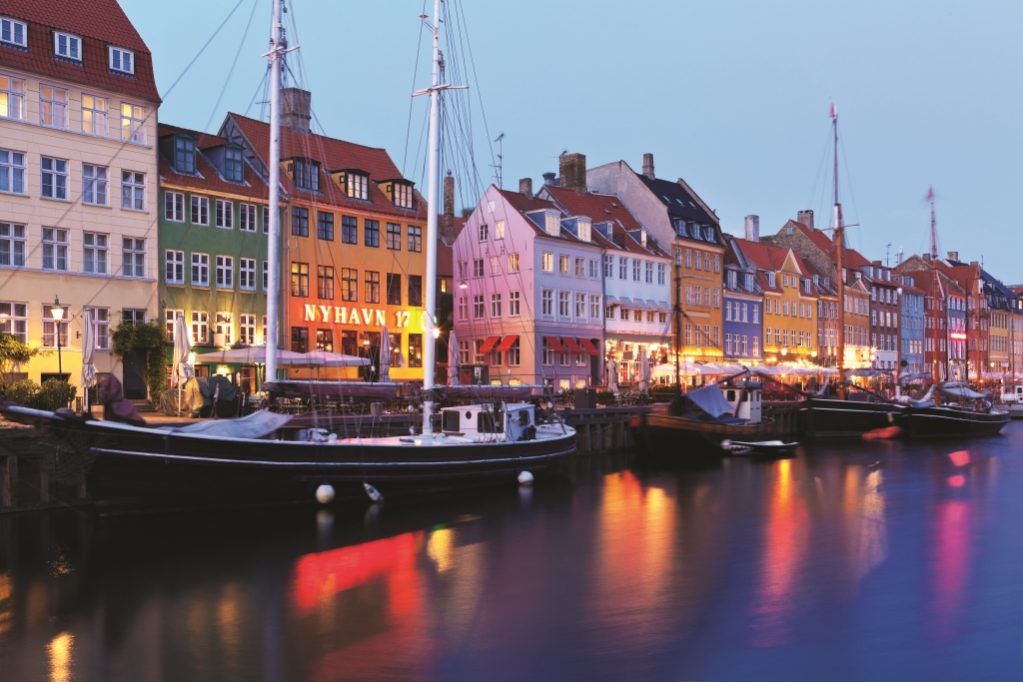Even though Copenhagen is a small city, a mere 88 square kilometers in size, being centrally located is important if you’re on a tight schedule. However, if you do need to use public transport, there is free Wi-Fi on subways, trams and buses. The Lakes, a popular jogging ground, are within walking distance from Nørreport, the main train station.
There is no need to worry if you forgot to pack an umbrella—it rains on average 155 days in a year—need a shirt or want to invest in a well-fitting suit. Copenhagen has the world’s longest pedestrian zone of more than a kilometer, which is lined with shops that sell everything from international brands to Scandinavian fashion. Strøget Street, with its exclusive Illum department store, is the most popular shopping street, while Gammel Mønt, Store Regnegade and Pilestræde have a range of stylish, independent shops.
Take a stroll down Bredgade from here, through one of the oldest parts of Copenhagen until you come to Amalienborg, the home of the Danish royal family, and the impressive Marble Church, built in 1740. Not far from there is the Langelinie promenade and pier, home of the Little Mermaid statue, Copenhagen’s icon, that was donated by Carl Jacobsen, a brewer of Denmark’s famous Carlsberg beer.

The city’s hour-long canal boat tours will also take you past the mermaid and offer views of the most important landmarks, including the Royal Library, nicknamed the Black Diamond because of its dark glass façade. The library is not only worth a visit because of its modern architecture. Its coffee shop offers free Wi-Fi and one can look out onto the water through the enormous glass façade.
The Radisson Blu Royal Hotel, designed by world-renowned Danish architect Arne Jacobsen, towers over the city center. Its lobby is outfitted with Jacobsen’s original Egg and Swan chairs. To learn more about Jacobsen and his contemporaries, who made Denmark famous for its classic ‘Nordic Cool’ style, visit to the Design Museum and the Danish Design Center. You will get an important insight into the Danes’ mindset: design counts as much as functionality.
The most popular way to get around in Copenhagen is by bicycle. One in three residents use their bike to get to work along the city’s more than 300 kilometers of cycling lanes. Bikes are a great way to explore the city and because Copenhagen is flat, cycling is easy. Arriving at a business meeting on a bike will impress your Danish counterparts. The best part: cycling will cost you nothing, as the municipality provides bicycles free of charge at more than 100 locations throughout the city. They even have a built-in map to show you the way.
If you can’t get yourself to ride a bike, show that you are environmentally conscious by renting an electric car. At $67 a day, it’s cheaper than regular car rentals and parking is free for electric cars throughout the city. It’s all part of Copenhagen’s goal to become the world’s first CO2-neutral capital by 2025.
Surrounded by the North Sea, Denmark is famous for its fish, which makes a seafood restaurant an obvious choice. Fiskebaren, located in the über-trendy meatpacking district Kødbyen, specializes in locally caught fish and shellfish and is as renowned for its minimalist, industrial interior—the aquarium in the center of the space doubles as a fish bar—and its creative dishes. Copenhagen’s restaurants belong to the most expensive in Europe and a 15% service charge is added to the bill.
Noma, voted the world’s top restaurant in 2010 and 2011, is certainly the place to celebrate a business deal. But to get a table at this two Michelin-starred establishment, where Chef René Redzepi only serves produce from Nordic countries, you’ll either have to get very lucky or know far in advance that you will be coming: reservations have to be made as much as a year in advance.
A low-key alternative, ideal for lunch, is Denmark’s national dish, smørrebrød, which are delicious open sandwiches made from dark rye bread and topped with a variety of delicacies, such as Danish meat balls, fried fish, eggs, herring, roast pork or shrimps. Restaurant Schønnemann has been making smørrebrød since 1877; while Ida Davidsen—(with a restaurant of the same name) who is known as the ‘queen of smørrebrød’—has delivered her sandwiches all the way to Hollywood.
The capital’s new culinary hot spot, Torvehallerne, an upscale covered market with more than 80 stalls, gives a good overview of Danish delicacies such as local cheeses, organic sausages, artisanal honey, breads, olive oils, seasonal fruit and vegetables, fresh fish, wines and specialties from small Danish islands. Copenhageners are the biggest consumers of organic produce in the world. Anything fitting the buzzwords: green, sustainable, ethical and social, will sell here.
The city’s best cocktail bar, Ruby Bar, is a great place to relax. Invite your business partners to enjoy a Champagne Figure, a cocktail made from homemade fig puree, bitter chocolate, absinthe and champagne. Another good place to network is the Nørrebro Bryghus, one of Copenhagen’s famous micro-breweries. This beer bar belongs to former Carlsberg master brewer Anders Kissmeyer, who invents a new beer at least once a month. There are dozens of different beers to choose from and most are limited editions.
To show your business partners true commitment to Scandinavia, take them for a drink at the Icebar, Copenhagen’s coolest bar… literally. All its interiors—from the walls to the bar counter, furniture and cocktail glasses—are made from natural snow and ice harvested far above the Arctic Circle. Needless to say, the bar has to be kept at sub-zero temperatures to keep it from melting. But don’t worry, you’ll be given a cozy outfit that will keep you warm.
